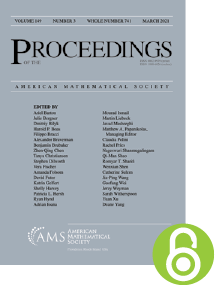The weighted discrete Gehring classes, Muckenhoupt classes and their basic properties
HTML articles powered by AMS MathViewer
- by Samir H. Saker and Mario Krnić PDF
- Proc. Amer. Math. Soc. 149 (2021), 231-243 Request permission
Abstract:
The main objective of this paper is a study of the structure and basic properties of the weighted discrete Gehring classes, as well as the study of the relationship between discrete Muckenhoupt and Gehring classes. First, we prove that the weighted discrete Muckenhoupt class $\mathcal {A}_{\lambda }^{1}(C)$, $C>1$, consisting of nonincreasing sequences, belongs to the weighted discrete Gehring class $\mathcal {G}_{\lambda }^{p}(A)$ by giving explicit values of exponent $p$ and constant $A$. Next, we prove the self-improving property of the weighted Gehring class $\mathcal {G}_{\lambda }^{p}({K)}$, $p>1$, $K>1$, consisting of nonincreasing sequences. The exponent and constant of transition are explicitly given. Finally, utilizing the self-improving property of the weighted Gehring class, we also derive the self-improving property of a discrete Muckenhoupt class $\mathcal {A}^{p}(C)$, $p>1$, $C>1$, with exact values of exponent and constant of transition.References
- Jonathan Bober, Emanuel Carneiro, Kevin Hughes, and Lillian B. Pierce, On a discrete version of Tanaka’s theorem for maximal functions, Proc. Amer. Math. Soc. 140 (2012), no. 5, 1669–1680. MR 2869151, DOI 10.1090/S0002-9939-2011-11008-6
- A. Böttcher, M. Seybold, Wackelsatz and Stechkin’s inequality for discrete Muckenhoupt weights, Preprint no. 99-7, TU Chemnitz, (1999).
- E. T. Copson, Note on Series of Positive Terms, J. London Math. Soc. 3 (1928), no. 1, 49–51. MR 1574443, DOI 10.1112/jlms/s1-3.1.49
- Michelangelo Franciosi, Weighted rearrangements and higher integrability results, Studia Math. 92 (1989), no. 2, 131–139. MR 986944, DOI 10.4064/sm-92-2-131-139
- Michelangelo Franciosi and Gioconda Moscariello, Higher integrability results, Manuscripta Math. 52 (1985), no. 1-3, 151–170. MR 790797, DOI 10.1007/BF01171490
- F. W. Gehring, The $L^{p}$-integrability of the partial derivatives of quasiconformal mapping, Bull. Amer. Math. Soc. 79 (1973), 465–466. MR 320308, DOI 10.1090/S0002-9904-1973-13218-5
- F. W. Gehring, The $L^{p}$-integrability of the partial derivatives of a quasiconformal mapping, Acta Math. 130 (1973), 265–277. MR 402038, DOI 10.1007/BF02392268
- G. H. Hardy, J. E. Littlewood, and G. Pólya, Inequalities, Cambridge Mathematical Library, Cambridge University Press, Cambridge, 1988. Reprint of the 1952 edition. MR 944909
- A. A. Korenovskiĭ, Sharp extension of a reverse Hölder inequality and the Muckenhoupt condition, Mat. Zametki 52 (1992), no. 6, 32–44, 158 (Russian, with Russian summary); English transl., Math. Notes 52 (1992), no. 5-6, 1192–1201 (1993). MR 1208001, DOI 10.1007/BF01209371
- A. A. Korenovskii and V. V. Fomichev, Self-improvement of summability factors of functions satisfying the reverse Hölder inequality in limit cases, Ukraïn. Mat. Zh. 62 (2010), no. 4, 483–493 (Russian, with Russian summary); English transl., Ukrainian Math. J. 62 (2010), no. 4, 552–563. MR 2888617, DOI 10.1007/s11253-010-0371-1
- Feng Liu, Endpoint regularity of discrete multisublinear fractional maximal operators associated with $\ell ^1$-balls, J. Inequal. Appl. , posted on (2018), Paper No. 33, 17. MR 3760362, DOI 10.1186/s13660-018-1627-9
- José Madrid, Sharp inequalities for the variation of the discrete maximal function, Bull. Aust. Math. Soc. 95 (2017), no. 1, 94–107. MR 3592548, DOI 10.1017/S0004972716000903
- A. Magyar, E. M. Stein, and S. Wainger, Discrete analogues in harmonic analysis: spherical averages, Ann. of Math. (2) 155 (2002), no. 1, 189–208. MR 1888798, DOI 10.2307/3062154
- N. A. Malaksiano, On exact inclusions of Gehring classes in Muckenhoupt classes, Mat. Zametki 70 (2001), no. 5, 742–750 (Russian, with Russian summary); English transl., Math. Notes 70 (2001), no. 5-6, 673–681. MR 1882347, DOI 10.1023/A:1012983028054
- Nikolay Aleksandrovich Malaksiano, The precise embeddings of one-dimensional Muckenhoupt classes in Gehring classes, Acta Sci. Math. (Szeged) 68 (2002), no. 1-2, 237–248. MR 1916578
- Benjamin Muckenhoupt, Weighted norm inequalities for the Hardy maximal function, Trans. Amer. Math. Soc. 165 (1972), 207–226. MR 293384, DOI 10.1090/S0002-9947-1972-0293384-6
- Arturo Popoli, Sharp integrability exponents and constants for Muckenhoupt and Gehring weights as solution to a unique equation, Ann. Acad. Sci. Fenn. Math. 43 (2018), no. 2, 785–805. MR 3839836, DOI 10.5186/aasfm.2018.4351
- S. H. Saker and I. Kubiaczyk, Higher summability and discrete weighted Muckenhoupt and Gehring type inequalities, Proc. Edinb. Math. Soc. (2) 62 (2019), no. 4, 949–973. MR 4017859, DOI 10.1017/s0013091519000014
- Samir Saker, Donal O’Regan, and Ravi Agarwal, A higher integrability theorem from a reverse weighted inequality, Bull. Lond. Math. Soc. 51 (2019), no. 6, 967–977. MR 4041004, DOI 10.1112/blms.12288
- Jan-Olov Strömberg and Alberto Torchinsky, Weighted Hardy spaces, Lecture Notes in Mathematics, vol. 1381, Springer-Verlag, Berlin, 1989. MR 1011673, DOI 10.1007/BFb0091154
Additional Information
- Samir H. Saker
- Affiliation: Department of Mathematics, Faculty of Science, Mansoura University, Mansoura 35516, Egypt
- MR Author ID: 650100
- Email: shsaker@mans.edu.eg
- Mario Krnić
- Affiliation: University of Zagreb, Faculty of Electrical Engineering and Computing, Unska 3, 10000 Zagreb, Croatia
- Email: mario.krnic@fer.hr
- Received by editor(s): March 26, 2020
- Received by editor(s) in revised form: April 29, 2020
- Published electronically: October 9, 2020
- Communicated by: Mourad Ismail
- © Copyright 2020 American Mathematical Society
- Journal: Proc. Amer. Math. Soc. 149 (2021), 231-243
- MSC (2010): Primary 40D05, 40D25; Secondary 42C10, 43A55, 46B15
- DOI: https://doi.org/10.1090/proc/15180
- MathSciNet review: 4172600


